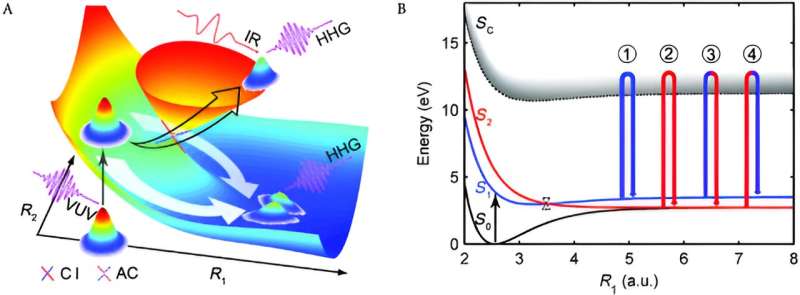This article has been reviewed according to Science X's editorial process and policies. Editors have highlighted the following attributes while ensuring the content's credibility:
fact-checked
proofread
Pump-probe high-harmonic spectroscopy could catch geometric phase effect around conical intersection in molecule: Study

A collaborative research team from Nanjing University of Science and Technology (NJUST) and East China Normal University (ECNU) has theoretically proposed that a pump-probe high-harmonic spectroscopy (HHS) driven by VUV-IR pulses can catch the geometric phase (GP) effect around the conical intersection (CI) and distinguish its quantitative behavior from the case of avoided crossing (AC). The results have been published in the journal Ultrafast Science.
In past decades, ingenious optical methods have been developed to probe the nonadiabatic dynamics in the vicinity of AC and CI which is responsible for many photophysical and photochemical dynamical processes. However, the direct discrimination between the AC and CI remains a formidable challenge to date.
As a novel spectroscopic tool for the ultrafast phenomena, HHS is particularly sensitive to the population and the coherence between the superposed states, which demonstrated its advantages in detecting the structure and dynamics of molecules. In view of this, investigate a qualitative distinction between CI and AC in polyatomic molecules.
In their article, the researchers from NJUST and ECNU utilize the pump-probe HHS driven by a few-cycle IR pulse to probe directly the GP accumulated around the CI. To model the pump-probe high-harmonic generation dynamics, they proposed a diabatic molecular model based on multiple 2-dimensional potential energy surfaces (PES) and solved the time-dependent Schrödinger equation in diabatic representation.
The results showed that the electronic coherence induced by the nonadiabatic coupling leads to the oscillatory feature in the high-harmonic spectrum in the case of AC, while the vanishing oscillations in the case of CI are consequences of the symmetry breaking caused by the GP.
Additionally, the above-threshold HHS indicates the dynamic blueshift which corresponds to the changing of the ionization potential as the pump-probe time-delay is increased. The direct probe of the GP-related dynamics, such as coherence and dynamical blueshift in the HHS, can be applied to monitor the nonadiabatic dynamics and the topological properties of PES with the sub-femtosecond resolution.
More information: Guanglu Yuan et al, Conical Intersection versus Avoided Crossing: Geometric Phase Effect in Molecular High-Order Harmonics, Ultrafast Science (2023). DOI: 10.34133/ultrafastscience.0040
Provided by Ultrafast Science





















